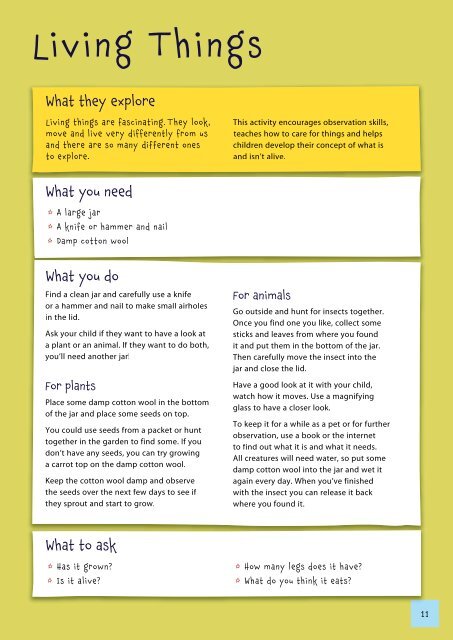Play-based science activities for early learners - Questacon Science ...
Play-based science activities for early learners - Questacon Science ...
Play-based science activities for early learners - Questacon Science ...
You also want an ePaper? Increase the reach of your titles
YUMPU automatically turns print PDFs into web optimized ePapers that Google loves.
Living Things<br />
What they explore<br />
Living things are fascinating. They look,<br />
move and live very differently from us<br />
and there are so many different ones<br />
to explore.<br />
What you need<br />
v<br />
v<br />
v<br />
A large jar<br />
A knife or hammer and nail<br />
Damp cotton wool<br />
What you do<br />
Find a clean jar and carefully use a knife<br />
or a hammer and nail to make small airholes<br />
in the lid.<br />
Ask your child if they want to have a look at<br />
a plant or an animal. If they want to do both,<br />
you’ll need another jar!<br />
For plants<br />
Place some damp cotton wool in the bottom<br />
of the jar and place some seeds on top.<br />
You could use seeds from a packet or hunt<br />
together in the garden to find some. If you<br />
don’t have any seeds, you can try growing<br />
a carrot top on the damp cotton wool.<br />
Keep the cotton wool damp and observe<br />
the seeds over the next few days to see if<br />
they sprout and start to grow.<br />
What to ask<br />
v<br />
v<br />
Has it grown?<br />
Is it alive?<br />
This activity encourages observation skills,<br />
teaches how to care <strong>for</strong> things and helps<br />
children develop their concept of what is<br />
and isn’t alive.<br />
For animals<br />
Go outside and hunt <strong>for</strong> insects together.<br />
Once you find one you like, collect some<br />
sticks and leaves from where you found<br />
it and put them in the bottom of the jar.<br />
Then carefully move the insect into the<br />
jar and close the lid.<br />
Have a good look at it with your child,<br />
watch how it moves. Use a magnifying<br />
glass to have a closer look.<br />
To keep it <strong>for</strong> a while as a pet or <strong>for</strong> further<br />
observation, use a book or the internet<br />
to find out what it is and what it needs.<br />
All creatures will need water, so put some<br />
damp cotton wool into the jar and wet it<br />
again every day. When you’ve finished<br />
with the insect you can release it back<br />
where you found it.<br />
v<br />
v<br />
How many legs does it have?<br />
What do you think it eats?<br />
11


